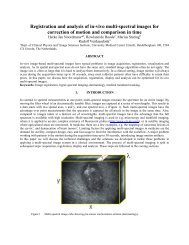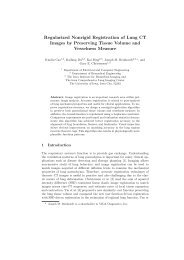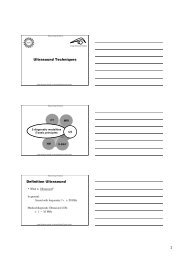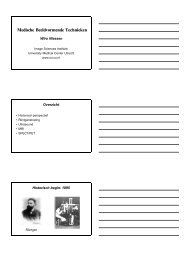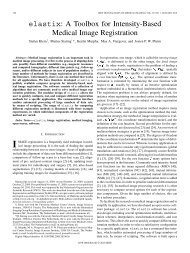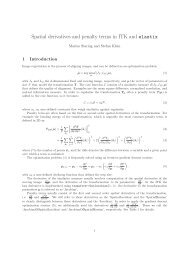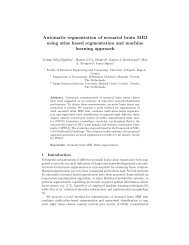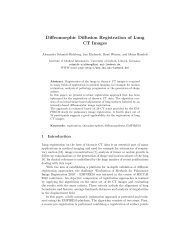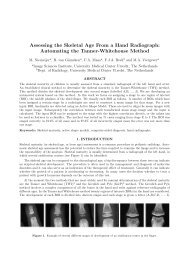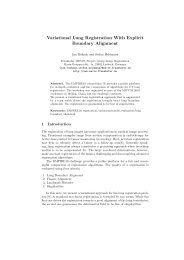Evaluation of a Rigidity Penalty Term for Nonrigid Registration - elastix
Evaluation of a Rigidity Penalty Term for Nonrigid Registration - elastix
Evaluation of a Rigidity Penalty Term for Nonrigid Registration - elastix
Create successful ePaper yourself
Turn your PDF publications into a flip-book with our unique Google optimized e-Paper software.
Table 1: Average lung overlap.<br />
be<strong>for</strong>e registration rigid similarity only with S rigid [u]<br />
0.64 ± 0.22 0.91 ± 0.06 0.98 ± 0.01 0.97 ± 0.02<br />
c(x)=1.0 in the tumour regions and 0.0 elsewhere.<br />
Accuracy <strong>of</strong> the registration is measured by calculating the lung overlap <strong>of</strong> the registered<br />
image with the fixed one. For this purpose automatic lung segmentations are made<br />
with an algorithm based on the method by Hu et al. [3,13]. The overlap measure is defined<br />
as<br />
overlap 2 ·|L 1 ∩ L 2 |<br />
|L 1 | + |L 2 | , (5)<br />
where L i is the set <strong>of</strong> all voxels from the lung, and where |L i | is the size <strong>of</strong> set L i . From<br />
the results reported in Table 1, we see that both registrations lead to good lung overlap.<br />
Employing a rigidity penalty term, constrains the de<strong>for</strong>mation, leading to a slightly less<br />
accurate lung overlap. Because <strong>of</strong> the (compact) support <strong>of</strong> the B-splines, a boundary<br />
around the tumour is influenced by the control points within the tumour. The extent <strong>of</strong><br />
this boundary can be controlled with the B-spline grid spacing.<br />
Manual segmentations <strong>of</strong> the tumours are used to evaluate their rigidity. Tumour volume<br />
measurements are per<strong>for</strong>med to see if the registration is at least volume preserving.<br />
In order to compare tumours volumes with different sizes we can not use the arithmetic<br />
mean, because large tumours influence the arithmetic mean disproportionally. There<strong>for</strong>e,<br />
volume growth ratios are calculated, where every tumour volume is divided by its volume<br />
at t 1 . For growth ratios it is better to use the geometric mean and the geometric standard<br />
deviation, which are defined as:<br />
√<br />
n<br />
µ g = n ∏r i ,<br />
i=1<br />
σ g = exp<br />
(√<br />
1<br />
n<br />
n<br />
∑<br />
i=1<br />
(lnr i − ln µ g ) 2 ), (6)<br />
where r i denotes the growth ratio <strong>of</strong> tumour i. We report the geometric mean growth<br />
ratios and standard deviations in Table 2. It can be appreciated that volume is much better<br />
preserved when applying the rigidity penalty term, compared to similarity only based<br />
registration. Part <strong>of</strong> the residual volume difference can be explained by interpolation<br />
artifacts due to resampling, as can be seen from the results <strong>for</strong> rigid registration. From<br />
the de<strong>for</strong>mation field, see Figure 2(f) (compare with 2(c)) is can also be appreciated that<br />
nonrigid registration using the rigidity penalty term preserves rigidity locally.<br />
3.3 Digital Subtraction Angiography<br />
<strong>Evaluation</strong> is also per<strong>for</strong>med on 2D clinical digital X-ray angiography image data, acquired<br />
with an Integris V3000 C-arm imaging system (Philips). Digital Subtraction Angiography<br />
(DSA) imaging <strong>of</strong>ten suffers from motion artifacts, due to motion <strong>of</strong> or within<br />
the patient, see Figure 3(a) - 3(c). <strong>Nonrigid</strong> registration is needed to compensate <strong>for</strong> this.<br />
We have 26 image sequences available <strong>of</strong> twelve different patients, each containing about<br />
10 images. Images are mostly <strong>of</strong> size 512×512 and are taken <strong>of</strong> different locations in the



